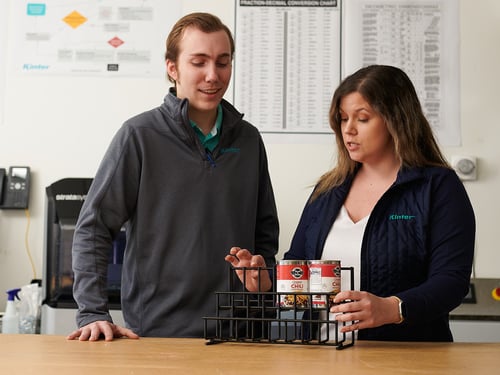- Products
- All Products
- New Products
- ESL / DSL Holders
- Label Solutions
- Display Hooks
- Product Merchandising
- Sign and Literature Holders
- Display Construction
- Rings and Binder Posts
- Ceiling Systems and Accessories
- Cable and Chain
- K-Stick Ladderless Sign Hanging System
- Fasteners
- Free Sample Rack
- siffron™ Part Number Cross-Reference Guide
- Custom Design & Capabilities
- Display Categories
- Resources
- About
+-
What is retail display hardware prototyping?
Retail display hardware prototyping is a process used to design and test new display systems before they go into full-scale production. This process is a critical part of the product development lifecycle, allowing designers, engineers, and manufacturers to create a physical model of the display system, assess its functionality, aesthetics, and durability, and make necessary improvements.
The prototype can be anything from shelving and attachments, racks, signage, product merchandising components, or any hardware intended to present products or signage to customers in a retail environment. The goal is to optimize the display for customer interaction, visibility, and the overall aesthetic of the store.
With advancements in technology, such as 3D printing and CAD software, the process of prototyping has become more sophisticated, allowing for greater precision, faster turnarounds, and improved cost efficiency. These advances mean that prototypes can closely mimic the final product, allowing for a comprehensive evaluation before moving to mass production. It also enables manufacturers to identify potential design issues early on, thereby preventing costly changes later in the production process.
+-
How does Kinter use prototype services to help customers?
Kinter’s prototype services benefit customers in various ways, including:
- Custom Solutions: Kinter offers custom prototype services, where our dedicated team of design engineers works closely with customers to develop unique solutions tailored to their specific needs. This may include brainstorming sessions, design consultations, 3D modeling, and the onsite rapid creation of a physical prototype for review and testing.
- Design Validation: Kinter uses prototyping to validate the design of display hardware and components. This means creating a physical model of the product to confirm it meets all specifications and fulfills its intended purpose effectively. Customers can then review the prototype, provide feedback, and request changes as necessary.
- Product Testing: Prototyping services allow customers to test an idea before they commit to a large order. They can assess the functionality, durability, and aesthetics of the prototype in a real-world context, ensuring it meets their requirements before they move into full-scale production.
- Market Testing: In some cases, Kinter produces small batch prototypes that can be used for market testing. This gives the customer an opportunity to see how the prototype performs in a live environment and gather feedback from end users, which can inform further design modifications.
- Speed to Market: Kinter’s onsite engineering lab and advanced prototyping technologies like 3D printing and CAD software allow for the quick and accurate creation of prototypes. This helps customers bring their product to market faster, gaining a competitive advantage.
- Cost Savings: By identifying design or functionality issues early in the development process, prototyping can save customers money by avoiding costly changes later in production.
Kinter’s prototype services provide an invaluable opportunity for customers to engage in a hands-on evaluation process, ensuring that the final retail display hardware aligns with their expectations and requirements.
+-
Why is prototyping important in the retail display hardware industry?
Prototyping is critical in the retail display hardware industry for a variety of reasons:
- Cost Efficiency: Prototyping helps to identify potential design and functionality issues early in the development process. This allows for changes to be made before moving into full-scale production, saving time, materials, and money that might otherwise be wasted on producing a flawed design.
- Improved Functionality and Aesthetics: By creating a physical model of the product, Kinter’s designers and engineers can assess its functionality and aesthetics in a real-world context. They can see how products will be used, how much space they will occupy, and how they will interact with other elements in the environment. This can lead to improvements in the design that enhance the customer experience and increase sales.
- Testing Durability: Point of purchase display hardware must withstand constant use and occasional abuse. Prototypes can be subjected to durability tests to ensure they can hold up under real-world conditions. This can prevent future breakages and the need for replacements, saving money in the long run.
- Customer Feedback: Prototypes can be used to gather feedback from potential customers or users. This can provide valuable insights into how the display could be improved to better meet customer needs and preferences.
- Speed to Market: With advancements in technology, prototyping can be done much more quickly and accurately than in the past, especially with onsite capabilities such as Kinter’s engineering lab. This can significantly reduce the time it takes to bring a new retail display product to market.


